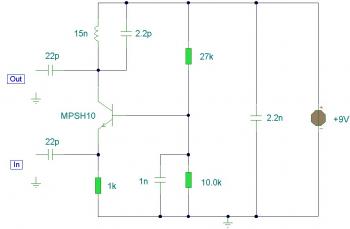This is the another UHF-TV pre-amplifier circuit diagram which simpler than the previous UHF TV preamplifier. This circuit is based MPSH10. Alternatives that could be put to use to replace MPSH10 are BF180 and BCY90. The tuned circuit comprising the 15nH inductor and 2.2pF capacitor resonate in the center of the UHF band. The 2.2pF capacitor could be exchanged for a 4.7pF as well as a trimmer capacitor of 2-6pF for better outputs.
The coil is half a turn of 18-20 SWG copper wire bent around a half inch drill bit. This ensures a low Q and therefore broad tuning. High frequency function needs special construction methods to prevent instability (unwanted oscillations) caused by feedback from output to input. Veroboard is not appropriate for this project as the capacitance between tracks is about 0.2pF. A better approach would be to use tag-strip or a PCB. The circuitry need to be enclosed in a metal case and also a screen made in between input and output. As the transistor is applied in common base mode,its low input impedance can be a great match for 50-75 ohm coax cable, whilst at the same time supplying full voltage gain towards the upper frequency limit of the device. The 15nH inductor load, having nearly a short circuit impedance at DC, has an impedance of 56ohms at 600MHz. This inductance and 2.2pF capacitor form a tank circuit at the transistors collector, delivering maximum gain at resonance. Note: even so that the voltage gain will probably be decreased under load, when the circuit is connected towards the input of a Television set or perhaps a quite long piece of coaxial cable as an example.
UHF-TV Pre-Amplifier circuit source: http://www.zen22142.zen.co.uk/Circuits/rf/uhfpreamp.htm
About RF Amplifier
An RF power amplifier is a type of electronic amplifier which is utilised to convert a low-power radio-frequency signal into a larger signal of significant power, usually for driving the antenna of a transmitter. It is usually optimized to have high efficiency, high output Power (P1dB) compression, good gain, good return loss on the input and output, and optimum heat dissipation.
The basic applications of the RF power amplifier include driving to another high power source, driving a transmitting antenna, microwave heating, and exciting resonant cavity structures. Among these applications, driving transmitter antennas is most well known.
More explanation about power audio amplifier can be found at wikipedia.org
This is a demonstration about 01A RF Amplifier which is build used old tube component to amplify the signal. An RF power amplifier is a type of electronic amplifier which is utilised to convert a low-power radio-frequency signal into a larger signal of significant power, usually for driving the antenna of a transmitter. It is usually optimized to have high efficiency, high output Power (P1dB) compression, good gain, good return loss on the input and output, and optimum heat dissipation.
The basic applications of the RF power amplifier include driving to another high power source, driving a transmitting antenna, microwave heating, and exciting resonant cavity structures. Among these applications, driving transmitter antennas is most well known.
More explanation about power audio amplifier can be found at wikipedia.org
Watch the video:

No comments:
Post a Comment